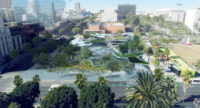People’s Park, an important site of the counterculture movement in the San Francisco Bay Area, is slated to be integrated into the mainstream. In the face of vocal opposition, the University of California, Berkeley, recently approved a $312 million project on the 2.8-acre property to create student housing. Designed by San Francisco–based Leddy Maytum Stacy Architects in collaboration with landscape architect Walter Hood, the development will retain 1.7 acres as public open space. It will be difficult, however, to capture a sense of the park’s informal DIY design in an institutional setting.
A large increase in student enrollment over the last decade, coupled with the area’s acute housing shortage, led UC Berkeley to scrutinize its real-estate portfolio for places to add another 8,000 beds. “We have to use all our options and develop on every single site to be able to get to that number,” says Wendy Hillis, campus architect and associate vice chancellor at UC Berkeley.
Created in 1969, People’s Park represented a win for 1960s communal culture over “the establishment.” The university originally acquired the land by eminent domain to build student housing in 1967. Local activists transformed the empty lot into an ad hoc park, setting the stage for a conflict that ended in a bloody clash between police and protestors. Since then, the park has been the site of peaceful gatherings, but also a hot spot for crime. During Covid, the park has served as a tent site for about 50 unhoused people.
As the project moves on to design development, the team is working out how to commemorate the park’s history while addressing the needs of the moment. A 12-story building will provide housing for 1,113 students, while another building will provide up to 125 units of supportive housing. According to Marsha Maytum, founding principal at Leddy Maytum Stacy, “There’s a lot of pressure on the site, given the number of units, to also meet the design goal of maximizing open space.”



Post a comment to this article
Report Abusive Comment